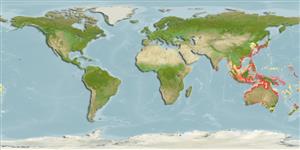Environment: milieu / climate zone / depth range / distribution range
Ecologia
marinhas; estuarina bentopelágico. Tropical
Western Pacific: Taiwan Strait (Ref. 47843), eastern Australia (Ref. 7300) and Papua New Guinea (Ref. 6192).
Tamanho / Peso / Idade
Maturity: Lm ? range ? - ? cm
Max length : 15.0 cm TL macho/indeterminado; (Ref. 3131)
Adults occur inshore. Omnivorous species (Ref. 7300). Eggs are guarded and fanned by the male parent (Ref. 205).
Life cycle and mating behavior
Maturities | Reprodução | Spawnings | Egg(s) | Fecundities | Larvas
Paxton, J.R., D.F. Hoese, G.R. Allen and J.E. Hanley, 1989. Pisces. Petromyzontidae to Carangidae. Zoological Catalogue of Australia, Vol. 7. Australian Government Publishing Service, Canberra, 665 p. (Ref. 7300)
Categoria na Lista Vermelha da IUCN (Ref. 130435)
Ameaça para o homem
Harmless
Utilização humana
Ferramentas
Relatórios especiais
Descarregue XML
Fontes da internet
Estimates based on models
Preferred temperature (Ref.
123201): 22.4 - 29, mean 28.1 °C (based on 886 cells).
Phylogenetic diversity index (Ref.
82804): PD
50 = 1.0000 [Uniqueness, from 0.5 = low to 2.0 = high].
Bayesian length-weight: a=0.01288 (0.00598 - 0.02775), b=3.05 (2.86 - 3.24), in cm total length, based on LWR estimates for this (Sub)family-body shape (Ref.
93245).
Nível Trófico (Ref.
69278): 2.0 ±0.00 se; based on food items.
Resiliência (Ref.
120179): Elevada, tempo mínimo de duplicação da população menor que 15 meses (Preliminary K or Fecundity.).
Fishing Vulnerability (Ref.
59153): Low vulnerability (10 of 100).
Nutrients (Ref.
124155): Calcium = 204 [129, 416] mg/100g; Iron = 1.27 [0.78, 2.14] mg/100g; Protein = 17.3 [16.4, 18.2] %; Omega3 = 0.244 [0.126, 0.457] g/100g; Selenium = 53.3 [27.2, 109.4] μg/100g; VitaminA = 29.5 [11.0, 76.4] μg/100g; Zinc = 2.74 [1.96, 3.82] mg/100g (wet weight);
